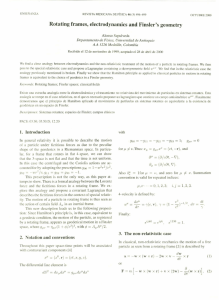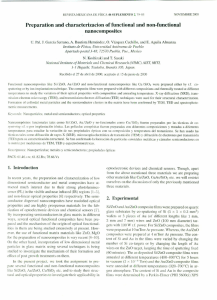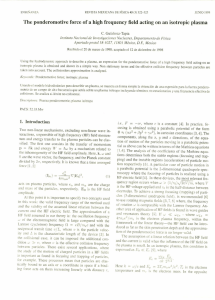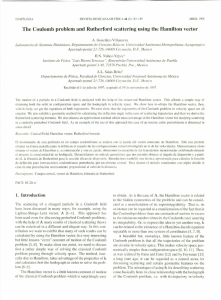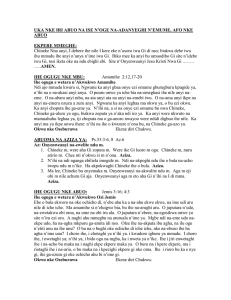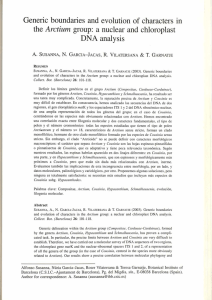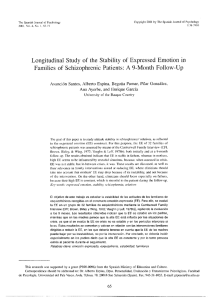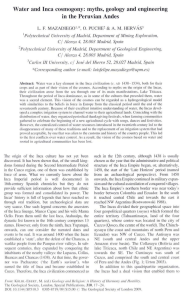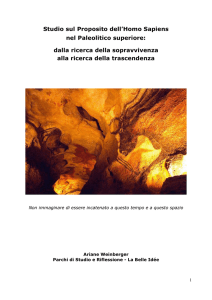Flow of granular materials in a hexagonal silo
Anuncio
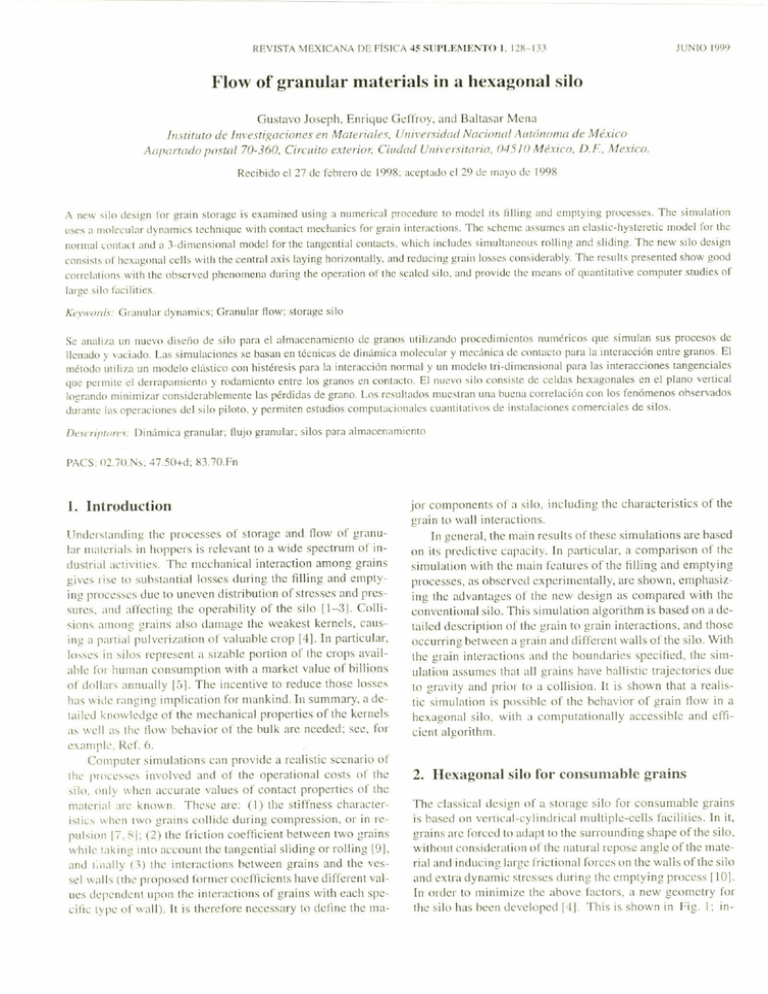
REVISTA ~tEXICANA
Flow of granular
Gustavo
Joscph,
DE FíSICA..fS SlJI'I.Et\tEI'lTO
JUNtO 1999
1. 12K-I.l~
materials in a hexagonal silo
Enrique
GeITroy". and Ballasa!" Mena
h,srilllto de /J",esrigaciones en Materiales, U/lin'rsido(/ Nacim1ll1 .\lffrJIlO11/{/ de México
r\(ll'arrado postal 70-360, Circuito exreriOl: Ciudad Ullil'('rsirori(/, 0-/5/ ()México, D, F, ,\fe:rico.
Recibido el 27 de febrero de Iq9R: accpt;luO el :2tJUl' mayo dl' 199¡;;
A new ...ilo dc ...ign ({lr grain ...t(lr:lgc is examined using :l numerieal proccdure to model ilS lilling amI emptying pfflcesses. Thc simulalion
use ...a molecular uynamics Icchniquc with cont:lct Illcchanics for grain inlcractioTls. The ...chcmc aSSU1llC'S:lnelastie-hysleretic model fm the
Illlfl1lalUllltact :md a 3-dimcllsionalmodel
for the tangcntial contact!-.. which incllldes sirnu1tancolls rolling and sliding. The ncw silo design
cOllsi...", 01"hcx"g.onal cclls witil the central axis laying hori70l1tally, <1111J
rcducing. gr:lin losses considerahly" Thc rcsults presented show good
corrclations wilh lhe ohsclved phenomena during the operation 01"Ihe scalcd silo. amI provide the mcans of quantitative computcr studíes nf
lar~C'...ilo f.lCilitíes.
K('ytl'ords:
(;r:lllular dynamics: Granular !low: slOrage silo
Se :llwli/a lln lllIL'\'Odisefio de silo para el almacenamiento de granos lIlili/ando proccdimicllIos numéricos que simulan sus procesos de
llenau(l y vaL'i41uo.Las simulaciones se basan cn técnicas de din:ímica molecular y Illec:ínica de contacto para la interacción entre granos. El
mélodo L1lilizaun modelo el:btico con histéresis para la interacción normal y un modelo tri-dimensional pnra las interacciones tangenciales
quc permitl' el derrapamicnttl y rodamienlo entre los granos en contacto. El TlUL'VO
~iltl consistc dc (cldas hexagonales en el plano vertical
[(lf!rando minimizar considerablemente las pérdidas de grano. Los rc.•.ultados muestran una huclla correlación con los fenómenos ohservados
durantc [;IS opera<:ioncs del silo pilolO. y permiten estudios compul:ll"ionalcs cuanlitativO" dc instalaciones comerciales de silos.
{}('.\("1"J/'((Jrn:
Din<Ímir:1granular; Ilujo granular: silos para ahnaCen;1I11icf1to
Pl\CS: 02.70.:\ ...: -l7.50+u: X3.70.Fn
1. introdllction
jor componenls
01"a silo, including
the charactcristics
of the
grain to wall interaclions.
Undersl:lIlding
the pnKesscs of stnragc 3nd fiow 01"granu~
lar material s in Iloppers is relevanl to a wide spectrum of induslri:ll ;ll'ti\'ities. The Illcchanical inleraction among grains
gi\'L's Iise to substanlial losses during the fllling and emptying processes dlle lo unevcll dislrihlllion of slrcsscs and pressures. ami allecling the operahility
01' the silo [1-3]. Collision .••alllollg ~r¡¡ins also dalllage lhe weakest kernel s, causing a partial pulveri/.alion
nI' valuable cmp [.l). In particular.
lo .••.•.
cs in silos represent a s¡/.able portion of Ihe eraps availahk ¡"nr human consumplinn
with a rnarkel value of hillions
01"dol1ars :lIll1ually 1;:)1. The inccntive {O reduce those losses
ha .••\Vide ranging illlplication for lllankinJ. In summary. a delailL'd kllowlL'dge of the Illechanical properties of the kcrnels
a... \Vcll " .••the Ihl\\- hehavior nf Ihe hulk are llceded; SCC, for
Rl'f. (j.
COmpUIl'r silllulations can providc"
realistic sccnario 01
lile pnll,:cs"'es irl\'ol\'ed ami of Ihe oper:lIional cos1'; of lhc
~ilo. (111)' \\hell accurate valucs 01' conlacl properlies nf t!le
rnatl'l"ial are kJ1owll. Thcsc are: (1) lile stiffness charaelcr~
¡,tic ... wlwlI t\\'o grains collidc during compression,
nr in rcpulsionli.8-1;
(2) Ihe frÍl:lion cocflicient hCI\'.'een l\Vo grains
whili.' taking into account lhe t:lI1gential sliding ar rolling [01,
and 1;,1;I11ynl lhe interactions
hel\vCCn grains and lile vessel \Valls (111L'pnlpt)scd f¡mllCr coertlcients have dilTcrenl vallIes llL'l'Cndl'lll 1I1Hll1the illleraclions or grains with each speL'ilil' type 01"\\"all). It is thl'rcforc Ill'cessary lo delinc lhe ma~
In gcneral. the main results oflhcse simulations are hascd
on its pretlictive eapacity. In particular. a comparison
of the
sillllllation \vilh the Illain ,"eatmes of Ihe lil1ing and emptying
pnH.:l'SSeS, as ohserved experimenlally,
are shown, cmphasizing lhe alivantages of lile new design as compared wirh the
eonventionai silo. This simllialion algorilhm is haseJ on a de.
lailed description of the grain lo grain intcraclions,
amI those
occuITing hctweell a grain ami different \\.alls of the silo. \Vith
the grain inleractiolls
and lile hounl1aries
specitled.
lhc si m-
ulation aSSllllles that all grains havc hallistic trajectories due
lo gravily and prior to a collision. It is shown thal a rcalislic silllul¡llion is possihle of the hehavior of grain tlow in a
hC-\;¡gona! silo. wilh a cOlllpulaliona!ly
accessihlc <lmJ effi.
cient algorilhlll.
c.\<Implc,
2. IIcxa¡(ollal silo for COllslIllIahlc ¡(mins
The c1assical design of a storage silo for consumable
grains
is hascd IHl wrliL';¡l-cylilldricalmultiplc-cel1s
facililies. In it.
grains ale fon.:ed to adapt to Ihe surrounding shape 01' the silo,
willlout cOllsideratioll 01"the nalural repose angle 01' the malerial and inducing large friclional fllrces on the walls oí" lile silo
and cxlra dynamic stresses during Ihe elllptying process [101.
111urde!" lo minilllil.c tlle ahove faelOrs. a ncw geolllctry rOl
lhe silo has hl'en developcd 141. This is shown in Fig. 1: in~
FLOW OF GRANULAR
MATERIALS
I~ A IIEXAG()NAL
SILO
129
rotalioll ahouI the same center ami considering lhe prevailing
COnlal:l forres. The inlegratioll 01"Ihe Iranslational equalions
is perfofJned using Nev ..'ton's second law cquation considcring lhe SUIll of a1l forces acting on the particle. The techniquc
is well docul11enled hy Allcn ami Tildcslcy [121 and Rapa.
port ! l;~]. Ncwlon's cqualions for eaeh particle are given as
first-order
,,11+1/"2
n
l. Schcmaric drawing oflhe hexagonal silo cel!. A hallcry
or cells along Ihe principal axis nI' lhe cel! can fmm a Iarge slorage.;
facilily. Thc hOIlOITlpIares and lhe rwo inlerna! slahs are inclined
wilh Ihe natural repose angJc of Ihe grain.
fiGURE
clincd waJls, al an angle of 35 dcgrees relalive 10 the hori.
I.ontal plane, and supparting
mosl 01' the graio load are its
main characteristic.
During the Iilling process, Ihe grains
aJopt their natural repose anglc minimizing
grain friction,
unwantcJ pad:ing and pulvcrization
ol"the material. Furthcr.
more, Ihis gcomclry
reduces dynamic stresses thal are responsihle
los.
ror wall damage
anJ hre;Jkage
in cOllventional
si-
dilfcrence
=
11'1-1/2
equaliolls
(FU)
+ ~t
lJ
(l
•
wilh the supcrscript
particle's \'elocill'.
ror each spatial dimension
corresponding
its posilion,
r
=
:r.y.'::
() =
:r.y.Z.
+--...!:!..
(l
UPOII lhe partirle, /11 its mass,
Ihe gravitalional
acceleralion.
0.,
el
/1/
F
(1)
lo thc time-Slep, v is lhe
Ihc sllm of forccs aCling
lhe lilllc-stcp
lenglh, and
In ordcr lo integrate the rotational molion of the particle, il is nccessary to consider that: (a) applied torques and
angular mOlllcnta are 1Il0st casily evaluateJ
in the system's
fralllc of refcrcncc, hUI (11)oricntaliolls
are hest exprcsscd in
the hody-fixeJ I"ramc, in such a way Ihal the moment of in.
ertia tensor is diagonal all(ilitllc invariant. Thc orienlalion of
Ihe particlc is givcn in Hamilton's qualernion [141. and is cal.
cubted following a schetlle similar to that originally lIsed hy
I~vans II:l]. In particular, il is advanlagcous
lO evaluate forees
and torques in the spatial-fixcd
I"rame ami lhen to lransform
Ihe applied torquc in(o the hody-lixed frame in order to eaku.
ThL: silllulaleo hexagonal silo corrcsponds
lo our Iahora.
lory model 01"unll' 3 metric ton s of corn capacily. However,
Ihe rcsults prcsenlcJ are ¡hose ohservcd qualilatively as wcll
in a 500-ton hl'xagonal silo located al San Miguel de Allende,
México. Thus, Ihe simulated hchavior ma)' he typical 01"even
larger cells. In rhe bhoratory
model, all walls are made of
late the rotatiol1 of the grain, and vice versa. Time derivali\'es
of lhe angular velocilies are t1clincd in the hody-fixed frame
01"rcfcre!lcc hy Euler's cqualions
lransparcnl acrylic sheels O.S inches of thid:.ncss. lo facililale Ihe visualizalion
of diverse phcnomena such as packing,
structurc :lnd ordering 01' grains, l10w c1K1raCleristics, ami olh-
\\ihcre the tensor 01" inenia
ers properlies ami conditions or rc.levancc ror OUf sludies, cf.
fCCls lhal are currently heing cvalualed cxperimentally.
ThL: hexagonal
design presenls othcr advantages.
Any
llulllher of c('lls may forrn the silo as lhe one descriheJ ahovc.
During filling ami unloading opcralions a conlilluous Illoniloring 01"Ihe pressurcs inside the silo can he done lo determine lhe dischargcd amounl, ano Ihe conlcnls 01"lhe silo can
he calculaled al aH times. In addilion, Ihe hexagonal design
can incorporale a solar encrgy system to assisl in Ihe control
01"lhe storage l:onditions 01' the silo 15, 11]. Pinally, Ihe eSliIllaled cosl 01"a vertical typc silo, fulIy equipped, is al least
20% more expensive lhan the hexagonallype
caparity and cquipment.
3. Sirnulatinn nI' the granular
no",
.tj
l'~ -- 1JI'
,vi) =
N"JI -
w/} 1';,
v->,
(diagonal)
(1 l' .
,v'l,
for Ihe particle
(2)
is 1,,,
w"
is Ihe angular \'clocily in lhe hotly-flxed frame, and N"
is (he Illcasurcd lorque in (he S:\lIIC frame of refcrence. Because 01"Ihe depcntlencc 01' lhe angular accelerations
on Ihl'
angular \'eloeities, a cOITector.pretliclor
(pe) schcrne is lIsed
to integrale Ihese accelcratiolls.
The torque N"p is knowll al
each lilllc-slep. and angular velocities al each half-time slep
IU
(..<.,
n
=(,.".'
11-1/1
n
~
'I~I
':.un
+--:!
n
=
:r,y.::.
(3 )
Oricnlations !leed a carcful evalualion hecause alllorques
are
given in lhe hody-fixed !"r:lI11e.rarticle conlacts are pretlicled
in lhe srace-lixcd
frame 01' rcfercllce.
silo of the same
4. Partil"ie-partic!e
Illntinn
It is possihle lo simulale Ihe
of granular Illaterials us.
ing molecular dynamics
lechniqucs.
in conjunclion
\vilh a
dcrai!L'd hal<lllCC 01" forces when two defonnahle-spherieal
grains l:ollidc. 11 is t!len natural lo represelll the motion of
a grain hy lhe translaiion al' ils ccnler of mass. as \\'ell as the
contad
interactinns
The inelastic nalure of the collision 01' lwo grains is lhe me.
chanical property 01"intcresl. Thcrc are t\\"o phenomena
for
¡hese inleractions:
(he loading antl lInloading of compressive
forccs Ihal tlcforrns Ihe Iwo surf:ll'es of ('ontacl, and Ihe fricrion forces tlue to dilTerel1l langcntial vclocilies al the ruinl
01"(Ol1tact. That is, a portioll 01' lh~ kinetic ellergy or the colIisioll is loSI via a restilUtion l'oefficicnt (smaller than unily)
Rel: Me.\'. Fís. 45 Sl (1999) 12X-I~J
GUSTAVO JOSEPH, ENRIQUE GEFFHOY, AND BALTASAR ~IENA
UlI
along lhe dircclion nf normal contact hetwccn grains. Also.
duc 10 lhe presence 01' a friclion coefllcicnt, lhe silllulation
considcrs cxchangcs 01"angular mornenlUm during lhe collisioll. Thc changcs of angular momentum afe couplcd 10 Ihe
norlllal fon:cs during lhe contaet with an overall dccrc<lsc nI'
rotatioll and energy 10SI appcaring as dissipated heal [I5}.
Thc comprcssivc loading alld unloading phcnoI1lcna are
characlerilCO hy linear (dastic) constitutivc cquations. \\'ith
cOllstan! stilTncss cocflicicnts. Thc inclastic naturc 01'lhe COBlaels appear as a rcsult 01' assigning a sliffncss cocfllcicnl
/\."1. during loading. ami a highcr vallle rol' Ihe unloading
slilTncss cocffi('icnt, [\'2, which cnds the prc\'ailing normal
fon.:e al a dislall('e (l'-no fmm Ihe original poinl 01' COI1I<lel. The t.:ocrtlcielll 01' rcslituliol1 é has a constanl value of
E =
[\'1/ f\"2, [\-2 > f\"" :lIld is related 10 Ihe dissipatiol1 of
kinelic energy hy Ihe l'olliding grains. This model resemhlcs
Il1a( 01' Hcrll.ian conla<.:lS, ¡¡nd has been uscd in nUlllcrous silllulalions 01'granular Illalerials [8,9]. In Ihe \Vahon amI Braun
model [7]lbe normal forcc is given by
J
during loadiug.
calculale lhe di"placelllL'nts 01' the poinl 01"contac! lO cvaluale lhe compnnCIl(s 01' Ihe applied rorces along lhe normal lo
lhe planc 01' contacl, as wcll as lhe forees on lhe planc. The
blter displacelllents Illust he cvaluated along Ihe dircclion 01'
lhe langcllIial force. and perpendicular lO i~.Lcts assulllc inf1nilesilll.lIly smal! dbplacelllcnts.
and let Kij he lhe instanlanCOllS unilary vector joining Ihe centers of grains 1 amI J
al Ihe prcscnl Slcp-limc:
J')
(6)
0'-
J(lj is normal 10 IhL' inSlantancous plane
contact. To updale
(Iw langL'lllial fOlTL'SappliL'd 011 lile collision, the tangential
force Tl'rl'v is projccled on Ihe plane of conlacl as
Lo
-
=
Kij
=
Tpl'l'v
x TpTt'v
-
X I(ij
(7 )
l(ij(l(ij . TpTI'v)'
-
\Vilh Ihe kinemalics 01'colliding grains t1efined, it is now possible 10 c\'aluale aH relalivL' displacements at Ihe point of conlael hy
<lllrillg loading.
,-","-1/'2
The friclion forces arc cakulated
ancr evaluating the lan.
gential forces al Ihe poinl 01' contact. The langenlial cfft:c(ive rigidily along Ihe direclioll parallello the presenl friclion
fort:e is gi\'ell hy
=
[1(,) x (vj'-1/2)
+/1)
=
.:.\I'ij-
.
I(lj
(5)
inneasing T.
wilh /\"0 Ihe inili¡¡llangenlial rigidily, T Ihe prcsenl tangenli:il
force, :Jnd '1'. lht.~uppcr (01' lowcr) hound rol' the stress during cach cyele, hL'I'ore a changc in Ihe direclion 01' rota(ion
(willl a starting value equal lo I.ero, and taking (he value 01"
T whcnc\'cr a ch:lIlgL" in ils direclion occurs). Thc hchavior
shown is very similar lo Ihal predicled by Mindlin 116. IT]
ror frictioning elaslic sphcres.,
has a value 01' 1/3 in Ihe (:;I"C
(lf ~lilldlill
l\.lodl'111G] with friclion coeflkienl 11. 17m 111L'''L'
SiIllUJ¡¡tiolls. a vallle.::of f = 1 or:2 is used.
5. J)~'nalllicsal Ihe "poi nI of conlacl"
In ol\lL'r (o cakulalL' lhe frictinn forces, Ihe langcnlial forces
al IhL' poinl 01'conla('1 are Ilceded; thcse accumu1Jle in a 11011linear manner \\'ith re"pL'ct lo f1nile langcntial displacCIIlCtllS
aftL'r conlacl 01' partiL'1es. For }-dimensional grains, Ihe lan
gCl1li:l1 displacclllL'nls parallcl and perpendicular
lO Ihe in.
slanlaneOlI" villue of lhe friclion force necd 10 he calculalcd.
Thc \,e(,;lor SUlll of tangcnlial forccs due lo both displacclIlL'nls Illusl alway ....be.::smallcr lhan IIFiv, wherc 1I is Ihe friclion cocnicienl, amI F¡"li Ihe inslanlancous norllla] force. BUI
conlacl points eontillua!ly changc (hcir oricntalion during a
collision tille lo applicd slresses. Thercfore, il is ncccssary lo
4
+ Pi (0~-1/2 X I(i))
X I(i)
(0;,-1/2 x
('
Kij'
1(,))] '-"1.
) + [(P, -:;;1- '/" -
.:.\rij
+p) (0;'-1/2
increasing T.
Rel'. Me.\".
I'¡
-
Ir) - ,,,1'
X
-
x Kij
1(,))] '-"1,
)
(8)
wilh .6.ri) = r:j - 1';)-1 i" Ihe chance of relalive posilion
during Ihe lillle ~/. Suh"cripls i and j for Ihe velocilies v,
angular VL'locilies W, and radii fI refer (o grains 1 and .J respectively.
Kl\O\ving Ihe changes 01' orielllalioll ror lhe langenlial
conlacl force.::allll lile orienlalion 01"lhe grains, Ihe parallcl
¡¡nd perpendicular displacclllcnls
\vilh respec( lO Ihe direclion (lf Ihe langenlia! force, and wilhin IhL' langenlial conlacl
p\¡lIlL', are
,\.
_
~sll -
( \ ,,,-1/2
~s
-)-.\.
. t t..
_
"-.l~.L -
\ _n-l/"2
.:....}.~
-
\_.
--loSII'
(9)
Al Ihis poirH four importanl kinematic conditiOlh need 10 he
considel'L'd. F;rstly, lhe langelllial displacerncnl nn the cnIllact plane, and normal In Ihe langenlial force al lhe prcvious
timc-slep, .6.sl.providcs a1l inl"ormalion needcd lo calculalc
(he perpendicular langenlial force:
( 10)
givL'1l Ihal carliL'r displacemcnls
occur along lhe direclion
01' Ihe applied langenlial force. Sccondly, the condition for
ro1ling or sliding al IhL' poinl nI' conlact depends on the in.
slanlancolls normal force. 11 is lhen necessary lo update Ihe
valllC 01'T. proportionally lo lhe chance of lhe normal force
Fú -t5 SI (1999) 12X-I:D
( 1 1)
FLOW OF GRANULAR
MATERIAI.S
Thirdly. lhe cffcClivc langcntial rigidity cocfficicllt nceds lo
he updalCd. Using Eq. (2), ano lhe prcscnl vnlucs rOl" T and
T.' lhe updalcd directioll 01'lhe prcviolls tilllc-stcp tangcI11ial
force. is
IN A HEXAGONAL
131
SILO
lhe simulalioll cell. AIJ grains Ihat have a non-zero projection
along lhe y-axis ror thcir "rotated" ,"elocity collide \Vilh lhe
cOllcrele \Vall.
Lel/5l't
::;:::1'; - l'w he lhe unknown Jistance rrom lhe
\Vall-grain lo lhe cnlliJing parlicle. Thcn,
( 12)
Ir
lhe prcviolls
langcnlial
a]ong lhe ncgativc dircction
¡¡nd T + (~sll-I/l. t)/\"'j'
displaccl11cllt
01'lhe langcntial force . .ó.s'l-lj2,
< O, tllen a reversal orthe dircc-
tion 01' TI! has occurrcd. Al (his point in lime ami bascd on
Eq. (2), it is ncccss~uy lO compute lhe applicJ strcsscs aSSUIll¡lIg a t1ccrcasing valuc ror T. ano lhe ncw tangenlial rigidity
cocflicicnt is hased 011 a valuc T - r. > 0, allowing rOl'
a slllonlhly varying rigidity cocfficicnt. And tinaliy, Ihe IlCW
prcliminary valllc ror lhe langcntial fon:e is
T'=TII+T~.
( 1-1)
has a componenl
( 13)
1fT' > IIF,'\', lhenlhe currenl value for lhe langelllial force is
rl'-scaled up lo Ihe present value of lhe friclion force. Joseph
et (1/. 1181. and Walton (9I givc a delailed accounl 01'the oasic
ideas and lechniqucs used lo perform Ihe granular dynamics
sirnulalion covered in Sccs. 3-5.
6. I\oundary conditions for the hexagonal silo
Thrce Iypes of walls or ooundary condilions are needcd lo
simulate a silo. These "w<llIs" reduce lhe run-lime 01"simulalions lo rcasonaole expcclalions and correspond lo dynamics
rcpresentalive of (1) periodk houndary cnndilions (PBC), (2)
parliclc-concrcle inleracliolls, and (3) a false wal! nceded for
"mirmring" particles Ihrough a symmetric ooundary. PBC are
uscd along Ihe axis of symmclry of rhe silo (Ihe ;1'-coordinate
lays horizonlal and is perpendicular lo lhe hexagonal plollle),
ami are descrihcd in deta;1 in Re!"s. 12 and 13. PllC allow the
silllulation nf a Ihin si ice 01' the silo along Ihe .y-axis, permitling a redllclion of run-lime. The Ihickness of the slice is
onlya few grain radii, \Vide cnough 10 reduce possible corrc!alions 01' grain positions lo nn insignifkant level hetwecn
Ihe 1\\'0 ends. The particle-concrete
inleraClions reqllire silllulalion of conlacls of grains with the walls, with coefficicnts
lhal differ I"mm lhose among grains. The mirroring 01' grains
011 Ihe venical
symmelry plane uf Ihe silo Cllts the prohlem
hy one hall", reducing Ihe computer silllulalions accordingly.
Tlle symllletric houndary corresponds to the verlical plane
Ihrough the middlc of Ihe inlet and 01' lhe oUIlet of the silo
and perpendicular lo the fmnt and rcar walls.
Inleracliolls 01"grains-silo rcquire defining Ihe posilion ol'
Ihe wal! \Villl respect lo lhe simulalion cell, as wcll as the
pnlperties 01' Ihe wall-grain inleraclion. Thesc inlcracliolls are
prcdicated UPOIl grain-grain collisiollS, with lhe "\Vall-grain"
bcing infinilely massive, amI no transfer of linear or angular 1l1OmCnluIIl bcing possible. Thc reslilulion cocfliciellls of
lhe "wall-grain" are perfcclly rigiJ (a value of 1). Thc propcr
orienlalion of Ihe wal! is sel up using its quaternions lo represenl lhe rolatioll 01' lhe "\Vall-grain" onlo one of Ihe sides oí"
corresponds lo lhe distance fmm Ihe wall-panicle projeclion,
say ol1lhe .r.::-planc, lo Ihe colliding grain. The y-component
nI' such projeclioll 6l'f.~l.'is lhe shortest (normal) dislancc from
the grain lo the projeelcd silo wall. Hencc, l'wJ.. = A(órr,~t.)y
is :l veclor normal to the silo \\'all, wilh magnitude correspontling lo lhe dislancc from the colliding grain lo Ihe wall,
ami given in Ihe system's !"rame of refcrencc. It is also necessary lO define the extension 01' lhese walls, in conjllnclion
with lhe slmelme of possiblc perioJie bOllndary condilion.
These Iwo cnllslraints are casily carricd oul in lhe :rz-plane
projcclion \""ilh :1'1,'::( corresponding lo lhe lengths oflhe \Vall.
Ir
( 15)
Ihen lhe colliding grain will slrikc the silo wall.
Through the s)'mmelry pl:mc boundary, hesidcs the required mass, momcnlllltl and energy conservalion crileria, a
grain leaving lhe cell is insertcd precisely where il exileJ.
Thc conscrvation erileria are achie\'ed hy reflecling Ihe grain
propcrties upon its exil OUIof Ihe cel! as il" viewing Ihe grain
kinemalics Illrollgh a mirror. ¡\ grain wilh a ,I/-componellt of
velocily exils Ihe cel! ano ils conditions arc updalcd cOllsidering that ./', and .::-axes displaeemellls are conserved, while
y-axis tlisplaecmenls change signo ROlalions aoout Ihe;c and
z axes change sign, alhcit mainlaining its value for angulJr
momcnlum abolll lhc y-axis.
Placing lhe mirror boul1dary at a tixcd posilion imposes a
long correlation slrllcturc lIpon the granular malerial as seen
in Fig. 2. This spalial corrclalion can oe scen: (a) along Ihe
hne defining Ihe posilioll uf Ihe houndary, as wel! as (o) inlo
lile granular media, heginning \••..
ith the ordcring of particlcs
al lhe houndary, ami v.:ilh a depth inlo Ihe malerial of a fe\V
particles. An altcrnali\"e is lo lake the same kinemalic condilions 01"Ihe ..hard" mirror houndary, hUI assuming now Ihat
Ihe poinl nI' cxil for all grains depcnds on a random variahle
11/" such lhat () ~ lit. :5 1. As a grain gels near lhe mirror bOllndary. :1Il inslanlaneolls random posilion I'or Ihe exil
01"lhe particle (y-componenl 01"lhe posilion of Ihe mirror) is
assigned hy
,.,
'''")l'1i ((}1
i
,!J
-
rll'
+ (0~Il¡,-
1 )p;)Y'
( 16)
where (Ji is lhe radius 01' lhe exiling grain. In this way, Ihe
I1Ucluating-posilion morror bOllndary hreaks tlown any slrucIUl"eup lo dislallces nf one-grain radius. The random displaceItlent oí" Ihe rnirror is ohtaincd from a ranJom number generator Hh wilh \'alllcs uniformly distrihuled over the intcrval
(O, 1) wilh Ihe mcan posilion of the mirror al the plane 01"
R('I: Me\". F,~~.-t5 SI (1999) 12R-13J
1.12
(iUSTAVO JOSEPIl, ENRI()UE GEFFROY. AND HALTASAR MENA
(a)
(a)
(h)
FlCiURE 3. Simulations
inL'luding
O.OO-l-9III in diarnelcf.
(h)
Fl<;tlRE
2. (a) Stcady
1IIfe :lt the symmetry
statc now for a silHulation
w;llllypc
(b) Samc simulalion
al the sYllllllctric
[;llioll (ontais
7(XX) grains
conJilions
but with a concrete
p1<1l1c;\'oíds alC gcnerated.
in [he silllulation
Each Sill111-
ecll.
s)'mlllctry: the samc ooscrvation is !nade ahout Ihe cxil position 01' cach grain. Por lile silllulation 01' non-homogcncolls
granular l1l~lIcrials, lhe atlvcrsc cffccts nI' Ihe ftuctuating mirror should he Icss givcll that spalial corrclations prcscnl a Icss
sharply
peak location
of llcarcsl ncighhors.
7. Filling and cmplying proccsses of lhe hexagIInal silo
Gi\'l~n Ihe illlcrcs! 01' silllulaling
mirror
and (h) 0.010
boundary:
lTl. Thcrc
as in rig. 3. bUI
(a) particles
is no induccd
of
slnlC-
planco
ceH wilh a ¡¡,eJ-
posilioll rnirror bounJary. Slructural pcriodicity is induccd by lhis
l1ard sYllllllctry.
wilh Ihe same conditions
lhe fandom-positioll
a hexagonal
silo flllcd with
L'ereal grains, the results herc presentcd are those ror mail.c.
For aH ~imulations, an equivalenl sphere, \vith a constant diallleh:r 01' 0.00-1.9 III [191 is used, as well as other values rep-
A simulalion \\iilh ¡¡ tixcd-position
(non-random)
mirror
is shown in f'ig. 2a. wilh particles exiting the sirnulation cel1
al the bottorn; Ihe inncr slahs have also been consitlerctl.
Thcsc results silo\\' an anomalous ordered packing nf grains
at the rnirror wal!. When using a concrete \\'all, the siluation
is cqual1y unrealislic as SIHl\\'11 in Fig. 2b by Ihe prcscnce 01"
largc voids. Experimentally,
il is ohserved thal a complelely
uncorrelated
ordering ('xists at the central plane 01' the silo.
Figure 3 shows the reslllts o!llained when a randoll1 symmetric mirror wall is tlsed, wilh the central regioll not showing
a hard periodic struclure or voids as in Fig. 2. An interesting behavior is predictcd under lhose conditions:
grains are
leveled, even whcll grains are red al the top cenlral region.
Figure 4 sho\\'s the results for the steady velocity lield
of the granular media. Each arrow corresponds
lO the velocity 01" a grain, with the logarithm of ils speed proportional
to
reselltative 01' corn: a density nI' 1,200 kg/m3, ami a rack.
ing fractioll of 0.60. These silllulations and the spheres used
llave all ol1violls limilalion due to the marked e!lipsnidal geol1lL'try 01" Ihe natural corn kcrncls, and their hetcrogcneity
{)j" shapes.
si/.cs, ami spccilic dcnsities. Nnnethcless,
Ihis nr~1
approximation
is certainly adcquate ror a preliminary cvalllalioli 01" the ideas here presenled. \Valls nI' lhe silo are considercd as madI.' of concrete. FurlhermOfe, PBC apply in Ihe
.l'-coonlinate
with 0.02325 m 01" thickness for Ihe cell. This
Ihickness corresponds
roughly to len kcrncls r~H.iiinceded to
gllarantee a non-corrclaled
slruclure. These simulalions were
made with a computer wilh 30 MFLOPS capacity and run-
lhe length 01' lhe arrow. The gray colored scale also represcnts
the magnitude nf speed 01' parlicles, with lighter arrows heing
ahnut a hUlldrcd lo one Ihousand limes raster than the slower
grains. Figure 4 shnws a Illain !low, central core region, ahoul
the sizc 01' the convergenl chanllel belweell inclined platcs,
wilh a small conlrihution
01' mass !low from the ramps. The
!lo\\' at Ihe core region is ahout three ordcrs al' magnilude
raster Ihan average velocilies al Ihe far end 01" [he ramp. The
core /low also has a relevant slruclure: (a) the rastcst no\\' region eorresponds to grains falling into Ihe hulk ofthe granular
malerial wilh Ihe smallest eore section; (o) Ihe fast !low insidc
lhe hulk material. jusI !lelow the fastest !low region, shows
a signijicant expansion of its eore sizc, consislent with a reduclion of Ihe average value 01" its veloeity f1eld (the darker
limes less than a couple 01' days.
gray color clearly shows the dccreasc
Rl'I'. Me.\". Fú. 4SS1 (1999) 12X-133
in mean spceds).
FLO\V OF GRANULAR
t\.lATERIALS IN A ¡IEXAGONAL
SILO
lJ3
S. SlIllIllIary and conclllsions
For Ihe simulation of lhe filling nr discharge 01' grain silos, il
is .•.•
I1O\\'n thal a comprolllise
is Ileccssary nCI\Veen an elaborale, very accurale Illudel rOl"the particle-par(icle
inlcractiolls
amI a realistic model of such inleraclions,
amenalllc lo COIllputational \\'ork with lllallY particles. For these Sirnllia(ions
a sufficicll(ly realislic
twcen pairs 01' grains
volved. In parlicular,
(hat a realislic !lo\\' is
slage, Ihe model
ical particle-wilh
___
"'.
10
I
100 1000
Pr{;URE 4. Veloríties nI' grain parlicles for a simulalioll 01' sleady
state llow for 12000 particlcs. The gray rolor sralc shO\\'s the log¡l'
rithm ofthe partirle's speed. The inner and hottom s!ahs are shown.
'fhe central rore scc(ion shows a fasl !low nI' granular material.
Then: is a rcrirculation !low rcgion aho\'e Ihe ccnter 01" the ramps.
model is t.lesirahle rOl"inleraetions heas well as for the types of walls illIhc comprolllise
t:hOSCll here sl10ws
Illodeled rOl' Ihe hexagonal silo. Allhis
fm lhe grain is Ihe mos( simple-a
sphcrparliclc-parlicle
inlerac(iolls that inclut.lc
ctaslic-incJaslic
conlaCls with friclion. The use 01' Ihree lypes
of walls makes il possihle lo simulale (he ohserved Ilehavior
01' nur st:alcd sito. In lhcse walls, {he lllcchanics 01"eollisions
hecolllcs crilica!, for only wi(h (he proper choice 01' dynalllies one may predicl the ohservcd hehavior. Por lhis silo. it
is shO\vll Il1al lhe use of random mirror walls rol' s)'lllll1clry
planes 01' lile simulation cell allow rol' <111
eflkicnl and rcalistic cOlllplllation nf Ihe ollscrveo phellomena. The prcdicleo
granular !low resemhlcs dosely Ihat ohservcd
sea[cu Iahoratory silo. loaded wilh corno
Thcse ehanges on lhe veloeily lteld wilhin lhe eore may
illlply Ihal illlportanl variations nr the !low strcsses OCCllr.
Thc satllc cOllclusion can he reat:hcu hy the prcsencc nI" Ihe
indllced rccirculalion
now pattern Ihat is clcarly selup hall'
\Vay IIp Ihe ralllps. Por viscous 1100v,a similar hehavior at the
cntrancc of a contraclion
is Jue (o Ihe exislence nI' normal
strcsscs typkal 01"a non-Ncwtonian
(Boger Typc) fluid 120].
This recircllla(ion /low Illay also explain (he levelcd surface
01" (he granular material whcn stcauy state f10w conditions
prcvail, even \vhen lhe natural repose angle of sphercs is
much JilTerenl.
l. R. \ 1. Neddcrman. SIal ic\' (lIId kincmal ies o( g rWllllar 1IJat('ria/.\.
(Camhridge Univ. Prcss. Camhridge. UK. 1991).
2. G.H. Ris!()w <l1lt11l.J.lIenmann.
P!lysim A 2U (19t)5) 47..l.
in a three-lon
Acknowlcdgmcnts
\Vc lhank Ing. Jesús Carnacho ami personncl 01' the lvlachinc
Shop of (he t\lalerials R.escarcll Instilllle (I1l\1) ror thcir assislance wilh lhe l'{lnSlrUclinn 01' the scaled silo. GJ wOllld like
lO thank the h.'lhlWSl1ip Program nf (he National Alllonomotls
Univcrsily 01' Mcxico (UNAf\1). Bl\l wOllld like to lhank
PAPIIT-DGAPA
nf UNAjVl through ils gran(s IN302392 and
I NS0.1494. EG and BM thank CONACyT I(Jr Scholarship'
of
Ihe SNI Program. and rllnding lhrollgh grant 0073~A 702(1.
12. \1.f'. Allen am! [).J. Ti Idc",ky, COIIII)ltIcr Simulatioll
:3. G.If. Ristow. I'/¡ysicaA 235 (1997) 319.
1:3. D.e. Rapaport. TI/(' (11"/ (~( II/oleclllar
dYllamics
ICamhridgc Univ. Prcss. Camhridge. LJK. 19(5) .
.1. G. Joseph et 01.. Procccdings X!lth Intcrnational Congn.:~s OH
Rheology. cdited by A. At ..Kadi. J.f\l Dea!y. D.F Jame",. ami
~1.e. Williams, Quéhcc. Canada, (19t)6). p. 795.
I-J. 11, Gnldstcin. C/as.\ical ¡\fcclulllics.
\Vcsley, Reading. USA. 1(80).
;"). R,E. Ch:ívcz-t\1ontes. Tesis de Licenciatura.
OuímiGl. UNAl\1. 7\léxico. (1997).
Facultad
G. X. Zhang ('t o/ .. Proc. 321h. Annual J\1ceting nI' Ihe
Sciellce. 29 Oct-I N"ov.(1995).
de
Eng.
i. O.R.. Wallon and R.L. Braun, 1. Rheo!. 30 (J 9H6) C).tt).
8.
a.
o.R.
\Valton, in Particlllafe tll'o-plwsf' J/ow, Edited hy J\1.e.
Roco, (Buttcrworth.lleinemann.
Bostol1. USA. lt)93). Ch. 25.
p. RR5.
O,R. \Valton. Mec/¡, oIMaterials
1(, (19t)1) 23t).
1(J, A.Y. Potapov and CS. Camphell, Phys. Fluid\' S (19t)6) 2XH4
11. O.M. Galicia-Ávila,
UNAM.
México.
Tesis de Licenciatura.
(1997)
].;. P.K. ttall. J nuid
rae. de Ingcniería.
2nd edition.
.l'i/lllllatiol1.
(Addison-
,11",,11. t.1~ (19X3)401.
16. R.O. J\lindlin. 1. A')I)/. M('cll.
SOCo
oI Liq/fidl.
(CI:ll"cnl!on Press, Ox1"onL UK. 19H7).
[/,{III.\'.
17. R.D .. ""'1indlin and 11, Deresiewiez.
327.
ASA/E E 16 (1949) 2j{).
1. Apl,l. Mech
20 (1953)
18. G. Joseph. (Suhrnillcd lo 1. R/¡cologr. 1998).
la. D.R. Bronkcr. F\V. Bakkcr.Arkcma,
{l/ul
s!orag('
(d- graills
and C.W. Hall. Dry;,¡g
(///(1 oi!s('cd.l'. (Van Nostrand.Rheinhold.
San Francisco. USA. IlJ(2).
~(). R.l3. Bird. O. lIassager. R.C. Arrnstrong. and CF. Curtiss. J)y.
I/wllics o( PolYlllcric Fll/id.\'. Vol. 2. (Kinetic Thcory. John Wiley & Sons. Ncw York. USA_ 1997).
Rel'. ¡\fe.\'. F/s. -t5 SI (199t)) IlH-U]
